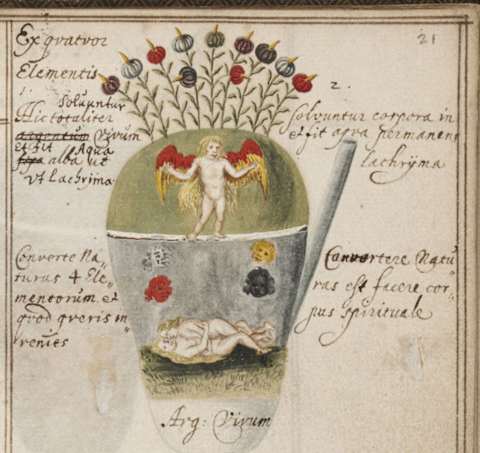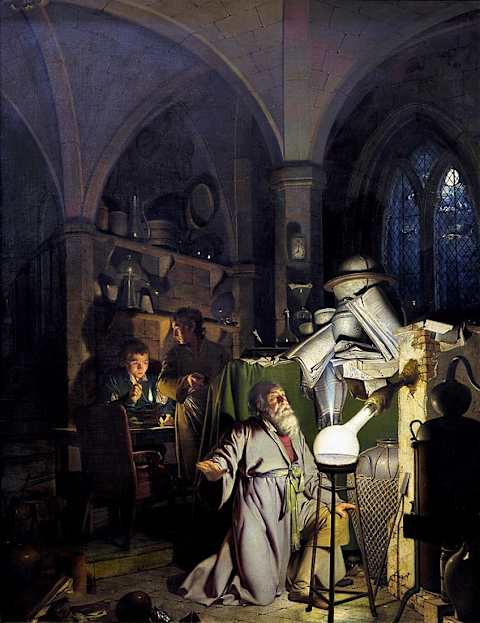Alchemy is an ancient art, originating in Egypt, that combines practical experiments and philosophical thinking around the nature of matter. While it’s often dismissed as quackery due to some of its outlandish objectives—like seeking immortality or changing lead into gold—the experiments carried out by alchemists have been credited with laying the foundations for modern science. Here are eight facts about this spooky practice.
The word alchemy derives from the old name for ancient Egypt.
The English word alchemy comes from the Arabic al-kimiya, which itself likely derives from the ancient name for Egypt, Khemia, meaning “land of black earth.” It refers to the Nile delta, where after seasonal rains the seemingly barren earth would be covered in bright green crops growing from fertile black soil. This linguistic origin points towards the basis of alchemy—that all matter might be transformed into something better.
Alchemy mixed proto-scientific experiments and mystical philosophy.
Although alchemy tends to be popularly reduced to the quest to turn base metals into gold, it was based on a far more complex blend of occultism, natural philosophy, chemistry, and metal working. Alchemists attempted to find answers to key questions, like “how are things made?,” “what are they made of?,” and “can one thing be transformed into another?”
Alchemy emerged in Greco-Roman Egypt in the 1st century CE and spread through the Byzantine and Arab world, absorbing ideas from Indian and Chinese culture along the way, before being reimagined in Renaissance Europe. While it was concerned with devising experiments into the properties of matter, alchemy also had a mystical and philosophical undercurrent. Alchemists believed that a deeper spiritual awareness was essential to their experiments, proposing that true enlightenment could only come through the interconnection of spirit and matter.
Practitioners sought the Philosopher’s Stone.
The Philosopher’s Stone—now mostly associated with Harry Potter—was a key alchemical quest. It was believed to be a substance which could speed up the transformation of materials, allowing common metals to be turned into silver or gold and, ultimately, providing the key to everlasting life.
Alchemists suspected that the Philosopher’s Stone might be an ordinary substance whose properties had yet to be discovered. As a result, medieval alchemists spent many hours experimenting with various substances to see how they interacted with others in the hope that they might eventually stumble upon this particular grail. Needless to say, they were unsuccessful, but their numerous experiments with metals, matter, and substances all added to our knowledge of materials and paved the way for the modern study of chemistry.
Many ancient alchemical texts have been lost or destroyed.

The oldest alchemical books were created in Egypt and, due to disasters like the burning down of the Library of Alexandria, many were lost or severely damaged. Much of the oldest knowledge survived only in fragmentary manuscripts. These traces of old alchemical texts were frequently combined or copied down incorrectly, so the information became garbled and ever more arcane, contributing to its mystery. Scholars found the strange symbolism impenetrable, and they often spent lifetimes trying to decipher the ancient knowledge contained within.
The Book of the Seven Climes (Kitāb al-aqālīm al-ṣab’ah) is one example. It was originally written in the 13th century by Abū al-Qāsim al-‘Irāqī but today survives only as lavishly illustrated 18th-century reproductions. The text has clearly been copied multiple times and its meanings have been hotly contested. As with many alchemical texts, the recipes are not written out plainly, but are represented by symbolism to indicate the processes involved. Animals are used to denote substances: an eagle stands in for sal ammoniac (a mineral also called “ammonium chloride”), and a raven represents either lead or iron. This makes much of the text very open to interpretation and the meanings elusive.
The first known alchemist was a woman.
Mary the Jewess (a.k.a. Maria the Prophet or Maria Prophetissa) is known only through Zosimos of Panopolis’s writings in the earliest surviving book on alchemy, published around the 4th century CE. He refers to Mary as a teacher or “sage” and indicates that she lived sometime between the 1st and 3rd centuries CE. Some traces of her writing survive in other texts, including a recipe for making gold from plants, but most of what we know of Mary comes from other alchemists. She developed pieces of scientific equipment that she used in her experiments, including the water bath or bain-marie (named in her honor), in which a container is nestled inside another and surrounded by hot water to ensure the contents of the inner container are not heated beyond the boiling point of water.
Secrecy was essential.

Alchemy surged in popularity during the Renaissance in Europe, but as the scientific revolution gathered steam in the 16th century, enlightened scholars began to view alchemical methods and quests as charlatanism. It was at this point that alchemy and chemistry split from each other: Chemists focused on evidence-based methods to understand natural laws, while alchemists became more concerned with mysticism and the metaphysical pursuit of immortality.
Unlike emerging scientific thought that relied on the free exchange of ideas, alchemy relied on secrecy. Concepts, methods, and recipes were recorded through symbolism and allegory, making their meaning obscure and imprecise. Some alchemists justified the secrecy by arguing that, without it, too many people would be making gold, the market would be flooded, and the economy would crash.
Sir Isaac Newton conducted alchemical experiments.
Isaac Newton’s vast contribution to modern physics is well known, but he also undertook investigations into alchemy and even sought to turn base metals into gold. Newton needed to keep these experiments under wraps, though: By the early 18th century, alchemy was viewed as heretical. His interest in alchemy became more widely known in 1936 when a substantial batch of his unpublished papers came up for auction at Sotheby’s in London. The cache of papers was bought by the famous economist John Maynard Keynes, and he kept the collection intact, allowing future scholars to study Newton’s alchemical writings.
One of the most startling discoveries was that Newton had written a recipe for the Philosopher’s Stone. Modern scholars continue to revisit Newton’s work on alchemy and reconsider its place in the history of science.
Alchemists made legit scientific discoveries.
During the 18th century, scientists discovered the principles of non-transmutable elements that form the basis of the periodic table. The knowledge debunked the idea that pure elements could be created by mixing others, seemingly placing the final nail in alchemy’s coffin.
But some historians argue that modern science owes a huge debt to alchemists’ exploration of the nature of matter. The work of alchemists, which tested materials and explored their properties, laid the groundwork for empirical science. Alchemists’ contributions include the discovery of new alloys and elements, such as phosphorus and zinc; the development of methods to manufacture acids; the invention of scientific equipment like the bain-marie and the tribikos (a glass apparatus for distillation); and setting the basis of scientific experimentation.
While the ultimate aim to turn lead into gold or find the key to immortality was never achieved (as far as we know), alchemists’ experimentation was an important step in our intellectual history.
Read More Stories About Spooky Stuff:
manual
